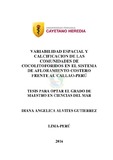Por favor, use este identificador para citar o enlazar este ítem:
https://hdl.handle.net/20.500.12958/3121Registro completo de metadatos
| Campo DC | Valor | Lengua/Idioma |
|---|---|---|
| dc.contributor.advisor | Graco, Michelle | - |
| dc.contributor.author | Alvites Gutierrez, Diana Angelica | - |
| dc.date.accessioned | 2017-04-04T20:08:45Z | - |
| dc.date.available | 2017-04-04T20:08:45Z | - |
| dc.date.issued | 2016 | - |
| dc.identifier.uri | https://hdl.handle.net/20.500.12958/3121 | - |
| dc.description | Tesis (Maestro en Ciencias del Mar).- Universidad Peruana Cayetano Heredia. | es_ES |
| dc.description.abstract | Por primera vez en Perú se estudió la composición, distribución, abundancia y grado de calcificación de la comunidad de cocolitofóridos. Este estudio se realizó en una transecta frente a Callao (12°S) desde la costa hasta las 50 mn, entre 2014 y 2015. Se determinó un total de 21 especies con dominancia de Emiliania huxleyi tipo A (76 % hasta 548x103cel/L), seguida por Ophiaster spp. (16%) y Florisphaera profunda (5%). Tres morfotipos de E. huxleyi fueron identificados: i) ligeramente calcificado L (40%), ii) medianamente calcificado M (35%) y iii) sobrecalcificado OC (25%). Los morfotipos e índices de calcificación mostraron diferencias costa-océano. Cocósferas de menor tamaño y un mayor índice RTW (grado de calcificación) caracterizó a las formas OC y M que predominaron en la costa en condiciones de afloramiento costero de Aguas Costeras Frías (ACF) y bajo pH. El patrón inverso se observó en la parte oceánica donde el morfotipo L dominó en condiciones de aguas cálidas ASS, mayor estratificación y pH. Este estudio evidencia la alta sensibilidad del grado de calcificación y distribución de cocolitofóridos a la intensidad del afloramiento costero y la distribución de las masas de agua que modifican factores claves como la temperatura, pH, oxígeno y nutrientes. | es_ES |
| dc.description.abstract | ABSTRACT For the first time in Peru composition, distribution, abundance and degree of calcification of the coccolithophorids community was studied. This work was conducted in a transect off Callao (12 ° S) from the coast to 50 nm, between 2014 and 2015. A total of 21 species dominated by Emiliania huxleyi type A (76% to 548x103cel/L) was determined, followed by Ophiaster spp. (16%) and Florisphaera profunda (5%). Three morphotypes of E. huxleyi were identified: i) slightly calcified L (40%), ii) moderately calcified M (35%) and iii) over-calcified OC (25%). Morphotypes and calcification rates showed differences between the coastal and oceanic areas. Coccospheres smaller and higher rate RTW (degree of calcification) characterized the OC and M forms characteristics under coastal upwelling conditions of Cold Coastal Waters (ACF) and low pH. The opposite pattern was observed in the oceanic part where the morfotipo L coexist with warm water conditions ASS, greater stratification and pH. This study demonstrates the high sensitivity of the coccolithophorids degree of calcification and distribution related with the intensity of coastal upwelling and the distribution of water masses that modify key factors such as temperature, pH oxygen and nutrients. | - |
| dc.language.iso | spa | es_ES |
| dc.publisher | Lima | es_ES |
| dc.rights | info:eu-repo/semantics/openAccess | es_ES |
| dc.rights.uri | https://creativecommons.org/licenses/by/4.0/ | - |
| dc.source | Instituto del Mar del Perú - IMARPE | es_ES |
| dc.source.uri | Repositorio Digital IMARPE | es_ES |
| dc.subject | Cocolitofóridos | es_ES |
| dc.subject | Afloramiento Costero | es_ES |
| dc.subject | Calcificación | es_ES |
| dc.subject | Callao | es_ES |
| dc.title | Variabilidad espacial y calcificación de las comunidades de Cocolitoforidos en el sistema de afloramiento costero frente al Callao | es_ES |
| dc.type | info:eu-repo/semantics/masterThesis | es_ES |
| Aparece en las colecciones: | Tesis de Postgrado | |
Ficheros en este ítem:
| Fichero | Descripción | Tamaño | Formato | |
|---|---|---|---|---|
| Alvites Gutierrez.pdf | 4,79 MB | Adobe PDF |  Visualizar/Abrir |
Este ítem está sujeto a una licencia Creative Commons Licencia Creative Commons

